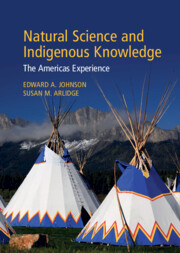Book contents
- Natural Science and Indigenous Knowledge
- Natural Science and Indigenous Knowledge
- Copyright page
- Contents
- Contributors
- Preface
- 1 What Do Indigenous People Have to Tell Us about the Cultural Landscapes They Have Created?
- 2 Reintegrating Cultural and Natural Landscapes
- 3 “My Uncle Was Resting His Country”: Dene Kinship and Insights into the More Distant Past
- 4 Native American Science in a Living Universe: A Paiute Perspective
- 5 “To Get More Harvest”
- 6 Hunting and Trapping in the Americas: The Assessment and Projection of Harvest on Wildlife Populations
- 7 On Fire and Water: The Intersection of Wetlands and Burning Strategies in Managing the Anthropogenic Plant Communities of Yosemite National Park
- 8 Indigenous Knowledge and the Kindergarten to Twelfth-Grade Science Classroom
- Index
- References
7 - On Fire and Water: The Intersection of Wetlands and Burning Strategies in Managing the Anthropogenic Plant Communities of Yosemite National Park
Published online by Cambridge University Press: 11 April 2024
- Natural Science and Indigenous Knowledge
- Natural Science and Indigenous Knowledge
- Copyright page
- Contents
- Contributors
- Preface
- 1 What Do Indigenous People Have to Tell Us about the Cultural Landscapes They Have Created?
- 2 Reintegrating Cultural and Natural Landscapes
- 3 “My Uncle Was Resting His Country”: Dene Kinship and Insights into the More Distant Past
- 4 Native American Science in a Living Universe: A Paiute Perspective
- 5 “To Get More Harvest”
- 6 Hunting and Trapping in the Americas: The Assessment and Projection of Harvest on Wildlife Populations
- 7 On Fire and Water: The Intersection of Wetlands and Burning Strategies in Managing the Anthropogenic Plant Communities of Yosemite National Park
- 8 Indigenous Knowledge and the Kindergarten to Twelfth-Grade Science Classroom
- Index
- References
Summary
The existing literature confirms that Native American tribes historically enhanced culturally preferred plant communities through periodic burning in what is today Yosemite National Park; in turn, beginning with nineteenth-century park development, fire suppression contributed to conifer and shrub encroachment on anthropogenic meadows and other culturally significant habitats. However, we contend that traditional burning practices cannot be understood without considering the pronounced cultural role of wetland habitats and species, and the intersection between burning practices and wetland plant communities among tribes of the Sierra Nevada Range. Our ethnographic investigations revealed that a majority of culturally important plants identified by tribal members in Yosemite Valley were wetland species. Interviewees also recall that traditional burning included wetlands and wetland margins – with the scale, timing, and location of burning responding to seasonal water-table fluctuations in those environments. Thus, US National Park Service (NPS) manipulation of valley hydrology eroded culturally significant plant communities over time, compounding the effects of fire suppression, together facilitating conifer encroachment. We present evidence of historical practices and trends based on a comprehensive review of available historical literature and ethnographic accounts, as well as the guidance of twentieth- and twenty-first-century tribal elders and the written record of NPS land management.
- Type
- Chapter
- Information
- Natural Science and Indigenous KnowledgeThe Americas Experience, pp. 201 - 232Publisher: Cambridge University PressPrint publication year: 2024



